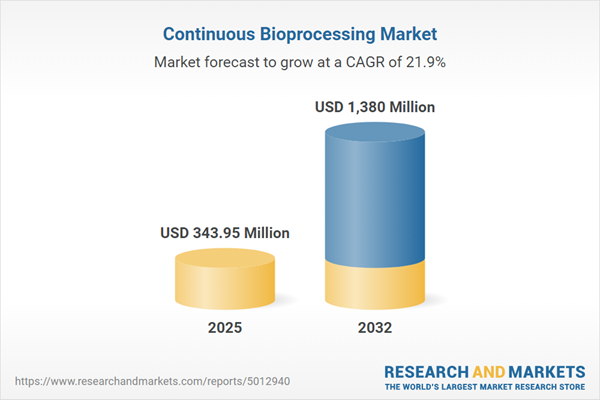Speak directly to the analyst to clarify any post sales queries you may have.
The continuous bioprocessing market is rapidly redefining global biomanufacturing, enabling agile, uninterrupted production processes. This shift is central for senior leaders seeking to optimize operational performance, enhance supply chain stability, and efficiently navigate evolving regulatory requirements.
Market Snapshot: Continuous Bioprocessing Market Size and Growth
The Continuous Bioprocessing Market grew from USD 282.42 million in 2024 to USD 343.95 million in 2025. It is expected to expand at a CAGR of 21.94%, reaching USD 1.38 billion by 2032. This robust upward trajectory is fueled by advances in process analytical technologies and increasing adoption of end-to-end automation. Strong demand for intensified cell culture strategies, combined with the growing need for manufacturing flexibility, is elevating market significance for stakeholders across pharmaceuticals, biotechnology, and contract production organizations globally.
Scope & Segmentation: In-Depth Market View
The report delivers an extensive analysis of the continuous bioprocessing market, examining product types, process stages, technologies, bioreactor types, end-users, and production scale. Key regional growth patterns and leading company strategies are also explored.
- Product Type: Includes cell therapies (CAR-T therapies, stem cell therapies), gene therapies (non-viral, viral vector), monoclonal antibodies, recombinant proteins (enzymes, growth factors, insulin), and vaccines (conventional, mRNA).
- Process Stage: Covers downstream bioprocessing (continuous chromatography, extraction, filtration) and upstream techniques (continuous cell culture, perfusion culture).
- Technology: Evaluates the adoption of continuous chromatography, continuous filtration, perfusion systems, and single use systems.
- Bioreactor Type: Compares single use bioreactors with stainless steel systems for varied scale and operational needs.
- End User: Analyzes biotechnology companies, CDMOs (large and small), pharmaceutical firms (big pharma, mid-tier), and research institutes.
- Scale of Production: Includes commercial scale (large, medium, small), laboratory reactors (< 50L, 50-200L), and pilot plants (< 200L, 200-500L, >500L).
- Geography: Assesses market across Americas (e.g., U.S., Canada, Brazil), EMEA (e.g., UK, Germany, Middle East, Africa), and Asia-Pacific (e.g., China, India, Japan).
Key Takeaways: Strategic Insights for Decision-Makers
- Continuous bioprocessing is driving a paradigm shift from traditional batch operations by supporting uninterrupted flows, enabling faster time-to-market for biologics and advanced therapies.
- Implementation of real-time analytical and digital control systems is minimizing process deviations and enhancing product consistency—critical for regulatory compliance and commercialization.
- Single use technologies and modular facilities are reducing capital outlay and supporting multi-product flexibility, which is particularly important in rapidly changing therapeutic landscapes.
- Collaboration between manufacturers and regulators is fostering the development of standardized platforms and best practices, accelerating adoption of continuous modalities across the industry.
- Regional regulatory developments influence adoption strategies, with North America benefitting from proactive guidelines and Asia-Pacific leveraging capacity expansion to meet rising healthcare demands.
- Innovative partnerships among equipment suppliers, technology developers, and contract manufacturers are creating new value chains focused on operational integration and agile production capabilities.
Tariff Impact: Navigating Trade and Cost Pressures
The 2025 tariff schedule in the United States is causing upward pressure on costs for raw materials and specialized equipment such as single use assemblies and filtration membranes. Organizations are responding with alternative sourcing, inventory recalibration, and local manufacturing initiatives. This environment has intensified dialogue with policymakers over trade classification and harmonization, further impacting strategic sourcing decisions and supplier diversification.
Methodology & Data Sources
This report leverages primary interviews with key executives, process engineers, and regulatory experts, supplemented by secondary research from peer-reviewed publications, industry reports, patent data, and conference materials. Data triangulation ensures validation of both qualitative insights and quantitative market indicators.
The Role of Continuous Bioprocessing in the Industry
The primary keyword, “continuous bioprocessing,” anchors the focus of this research, offering clear direction for organizations aiming to achieve sustainable manufacturing, enhance operational efficiency, and proactively respond to regulatory trends. The analysis also covers secondary keywords such as "single use systems," "process analytical technologies," and "supply chain resilience."
Why This Report Matters
- Supports informed investment and operational decisions on adopting next-generation bioprocessing technologies and strategies.
- Provides in-depth competitor, technology, and regional analysis for a clear understanding of risk and growth opportunities.
- Guides strategic planning in context of evolving tariffs, regulatory frameworks, and industry standards.
Conclusion
Continuous bioprocessing is emerging as a vital enabler of supply chain resilience, manufacturing agility, and innovation. Senior leaders can leverage insights from this report to shape strategies and unlock opportunity in a complex, evolving market.
Additional Product Information:
- Purchase of this report includes 1 year online access with quarterly updates.
- This report can be updated on request. Please contact our Customer Experience team using the Ask a Question widget on our website.
Table of Contents
3. Executive Summary
4. Market Overview
7. Cumulative Impact of Artificial Intelligence 2025
Companies Mentioned
The companies profiled in this Continuous Bioprocessing market report include:- Thermo Fisher Scientific Inc.
- Danaher Corporation
- Merck KGaA
- Sartorius AG
- Lonza Group AG
- FUJIFILM Diosynth Biotechnologies
- Repligen Corporation
- Novasep Holding SAS
- Applikon Biotechnology B.V.
- Parker Hannifin Corporation
Table Information
| Report Attribute | Details |
|---|---|
| No. of Pages | 184 |
| Published | October 2025 |
| Forecast Period | 2025 - 2032 |
| Estimated Market Value ( USD | $ 343.95 Million |
| Forecasted Market Value ( USD | $ 1380 Million |
| Compound Annual Growth Rate | 21.9% |
| Regions Covered | Global |
| No. of Companies Mentioned | 11 |







![Single-use Bioprocessing Market by Product (Equipment [Bioreactors, Filtration, Chromatography], Consumables [Filters, Bags, Assemblies, Sensors]), Application (Storage, Mixing), Workflow (Upstream), Molecule Type (mAbs, Vaccines) - Global Forecast to 2030 - Product Image](http://www.researchandmarkets.com/product_images/12020/12020910_60px_jpg/singleuse_bioprocessing_market.jpg)

